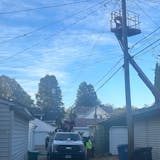Kate Gillen brought one of her most precious possessions when she came to speak to a health class at Park High School in Cottage Grove: a purse-sized photo album filled with snapshots of a growing boy and his parents.
Students who passed it from desk to desk seemed to handle it with reverence, glancing from the baby pictures to the 33-year-old communications executive standing in front of them.
"That's my son," Gillen said. "And his mother and father."
Gillen is a volunteer with the Adoption Option Council of Minnesota (AOCM), an adoption advocacy nonprofit that sends panels of speakers — birth parents, adoptive parents, adoptees — into high schools. While AOCM has no political or religious affiliation, it does have a goal — to put adoption on the list of choices that young people might contemplate should they experience an unplanned pregnancy.
"Adoption has been mysterious in the past. We want students to see it for what it is today," said Jenny Eldredge, AOCM executive director and the adoptive mother of two. "If a student or one of their friends would have a pregnancy before they can parent, our hope is they'll have a realistic idea of what adoption looks like after hearing these stories."
Getting birth parents to consider adoption is an uphill battle today. With greater access to contraception and abortion and a reduced social stigma for single parenting, fewer babies are available for adoption.
Fifty years ago, 95 percent of unmarried teen mothers placed their children for adoption, according to statistics cited by the Planned Parenthood Federation. Today, just 2 to 3 percent do. In addition, the number of teen births in Minnesota has fallen steadily — and steeply. According to the Minnesota Health Statistics Report, the number of teen pregnancies fell by 40 percent between 1991 and 2010.
"Over a lifetime, adoption touches many people. This effort lays the groundwork for adoption; it normalizes the process," said Heidi Wiste, director of social work for Lutheran Social Service and Children's Home Society. The combined agencies have assisted with adoptions for a century and a half. "Today, tomorrow or someday, this information may be relevant."

